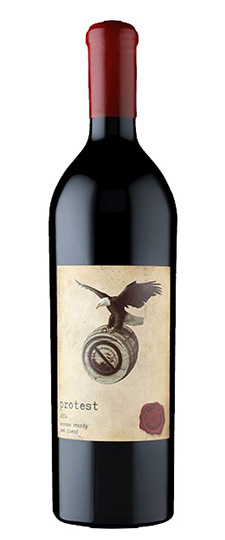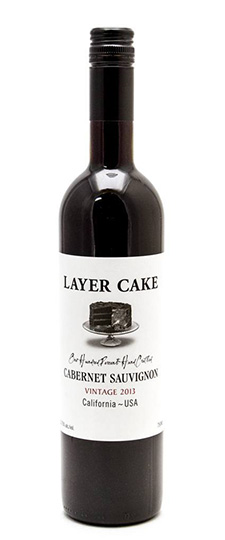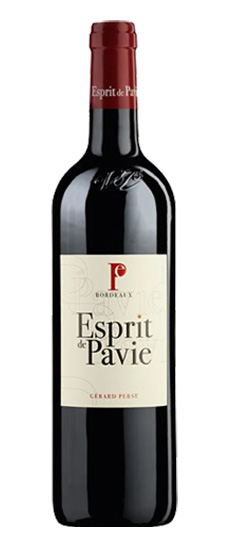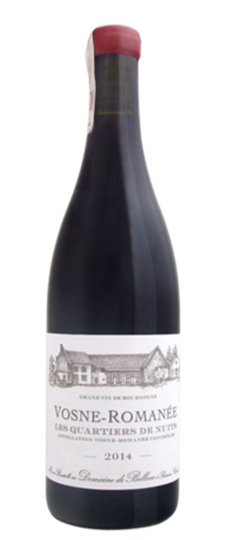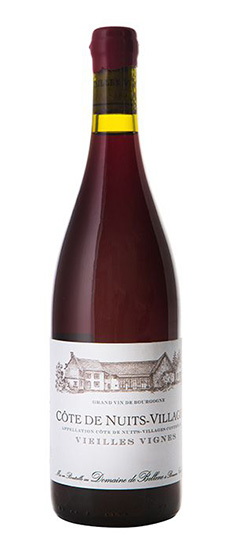Wine Score
Affordable Luxury” is what the folks at Layer Cake are looking for, and they seem to have hit the barrel on its head, so to speak. Mind you, that it’s California appellation doesn’t mean that it’s sourced from the vast Central Valley–Layer Cake pulls Cab from the great Cab-producing regions of Paso Robles in the Central Coast and Alexander Valley in the North Coast, hence the statewide level. It’s not every under $15 Cabernet that scores 90 points in Robert Parker’s Wine Advocate, as the 2010 vintage of this great value Cab did.
Grape Variety
Cabernet Sauvignon Wine
Cabernet Sauvignon is probably the most famous red wine grape variety on Earth. It is rivaled in this regard only by its Bordeaux stablemate Merlot, and its opposite number in Burgundy, Pinot Noir. From its origins in Bordeaux, Cabernet has successfully spread to almost every winegrowing country in the world. It is now the key grape variety in many first-rate New World wine regions, most notably Napa Valley, Coonawarra and Maipo Valley. Wherever they come from, Cabernet Sauvignon wines always seem to demonstrate a handful of common character traits: deep color, good tannin structure, moderate acidity and aromas of blackcurrant, tomato leaf, dark spices and cedarwood.
Used as frequently in blends as in varietal wines, Cabernet Sauvignon has a large number of common blending partners. Apart from the obvious Merlot and Cabernet Franc, the most prevalent of these are Malbec, Petit Verdot and Carmenere (the ingredients of a classic Bordeaux Blend), Shiraz (in Australia’s favorite blend) and in Spain and South America, a Cabernet – Tempranillo blend is now commonplace. Even the bold Tannat-based wines of Madiran are now generally softened with Cabernet Sauvignon.
DNA profiling carried out in California in 1997 confirmed that Cabernet Sauvignon is the product of a natural genetic crossing between key Bordeaux grape varieties Cabernet Franc and Sauvignon Blanc. Most wine authorities agree that this crossing happened only within the past few centuries, making the variety’s global fame and dominance all the more impressive.
There are two key reasons for Cabernet Sauvignon’s rise to dominance. The most simple and primordial of these is that its vines are highly adaptable to different soil types and climates; it is grown at latitudes as disparate as 50°N (Okanagan in Canada) and 20°S (northern Argentina), and in soils as different as the Pessac-Leognan gravels and the iron-rich terra rossa of Coonawarra. Secondary to this, but just as important, is that despite the diversity of terroirs in which the vine is grown, Cabernet Sauvignon wines retain an inimitable “Cab” character, nuanced with hints of provenance in the best-made examples. There is just a single reason, however, for the durability of the variety’s fame and that is simple economics; the familiarity and marketability of the Cabernet Sauvignon name has an irresistible lure to wine companies looking for a reliable return on their investment.
A vigorous variety (another characteristic in its favor), Cabernet Sauvignon produces a dense leaf canopy and relatively high grape yields, giving wine producers a fairly open choice between quantity and quality. Careful vineyard management is essential, however, to coax the best out of the fruit.
As a late-flowering and late-ripening variety, Cabernet Sauvignon grapes mature slowly. This can also work for or against wine quality; in a cold season or climate there is a risk of the grapes failing to ripen fully, while in most other conditions the steady rate of progress offers producers a wider choice of harvest dates.
Few would argue that the finest examples of Cabernet Sauvignon wine are found in Bordeaux and California, a standpoint supported by the 1976 Judgment of Paris. The past two decades have seen a raft of quality Cabernets emerging from New World regions such as Maipo in Chile and Coonawarra in Australia. These are gaining popularity with an increasingly broad consumer base as the world’s most prestigious Cabernet Sauvignon wines become prohibitively expensive. The variety has now made its way even into such established and traditional Italian names as Chianti and Carmignano (albeit restricted to 15 percent of the permitted blend), evidence that even the oldest and most traditional wine institutions now recognize the value of this most famous of grapes.
Synonyms include: Bidure, Bouche, Bordo, Bouchet, Burdeos Tinto, Lafite, Vidure.
Food matches for Cabernet Sauvignon include:
- Fillet steak with foie gras and truffles
- Beef wellington with honey roasted carrots
- Korean-style beef stir fried in garlic, soy and sesame
Region
Californian Wine
California is the largest and most important wine region in the United States. Occupying the southern two-thirds of the country’s west coast (Oregon and Washington make up the rest), it spans almost ten degrees of latitude and 850 miles (1370km) of coastline. With mountains, valleys, plains and plateaux, the state’s topography is as complex as its climate, offering winegrowers a bewildering choice of terroir.
Although Californian wines rose to global renown only in the past few decades (notably after the Paris Judgment of 1976), the state’s viticultural history dates back more than 200 years. The first vines were planted here in the 18th century, as European settlers and missionaries made their way up and down the west coast. They brought with them the Mission grape – the vinifera variety also instrumental in establishing viniculture in Central and South America. Although very few Mission vines are to be found in California today, it remains a cornerstone of Californian wine.
 The first half of the 20th century brought war, Prohibition and the Great Depression to the United States, collectively suffocating the nation’s once-burgeoning wine industry. It wasn’t until the significant social, cultural and economic developments that followed World War 2 that things began to change. In the 1970s, the leading lights of the Californian wine industry brought about renewed winemaking passion in other US states, ultimately sparking the national wine renaissance. This period saw a proliferation of new, small-scale wineries throughout the country and the upscaling of longer-established operations and created momentum that has continued into the 21st century.
The first half of the 20th century brought war, Prohibition and the Great Depression to the United States, collectively suffocating the nation’s once-burgeoning wine industry. It wasn’t until the significant social, cultural and economic developments that followed World War 2 that things began to change. In the 1970s, the leading lights of the Californian wine industry brought about renewed winemaking passion in other US states, ultimately sparking the national wine renaissance. This period saw a proliferation of new, small-scale wineries throughout the country and the upscaling of longer-established operations and created momentum that has continued into the 21st century.
Today, California hosts some of the world’s largest wine companies, but it is also home to a number of boutique wineries, some of which attract astronomical prices for their cult wines. Whether through mass production or single-vineyard artisanal winemaking, California produces 90% of American-made wine and supplies more than 60% of all wine consumed in the country, shipping a record 211.9 million cases in 2011.
The principal varieties grown in California are Cabernet Sauvignon and Chardonnay. A wide range of traditional European (Vitis vinifera) vines also flourish, grafted to hardy, phylloxera-resistant American rootstocks. Less well known are American/European hybrids producing wines mainly for local consumption. Many French Champagne houses have set up wineries in California. The most famous examples are Moet & Chandon’s Domaine Chandon, Taittinger’s Domaine Carneros, Louis Roederer’s Roederer Estate in the Anderson Valley and Mumm Napa in the Napa Valley.
Soils and climates vary substantially throughout California, according to a complex combination of altitude, latitude and proximity to the cool waters of the Pacific Ocean. As a rule of thumb, the more mountains there are between a vineyard and the Pacific, the less it benefits from the cooling effects of a maritime climate. In summer, the cold inshore waters of the Pacific help to create a fog bank just off the coast. As the inland air warms and rises, cold fog is sucked in to fill the space. In extreme cases, fog has been known to travel as far as 100 miles (160km) inland, cooling and refreshing the land as it goes.
Generally, the cooler regions closer to the coast are better suited to Pinot Noir and Chardonnay, while further inland – where the climate is much hotter – some of California’s most-famous Cabernet Sauvignon wines are grown. Zinfandel produces some outstanding examples throughout this important region.
To sum up the complex climatology, topography and geology of such a large area is impossible without losing the subtleties that make one wine different from the next and that ultimately make wine such an interesting topic. For specific information on each of California’s wine regions and AVAs, please use the links to the left.
Producer Notes
About Layer Cake
Winemaker Notes
When we set out to make Layer Cake Cabernet the goal was the same as the other Layer Cake red wines: find great vineyards that allow us to make a rich, delicious wine that tastes like $50, but costs less than $20. We tasted fruit from vineyards in the best regions of California, eventually settling on two main vineyards; one in Sonoma County’s Alexander Valley and one in sunny Paso Robles. The diversity of these two vineyards allows us to make a final blend that expresses the concentration, complexity and richness Layer Cake fans have come to expect.
Vineyard Notes
Our vineyard in Alexander Valley is a classic example of the appellation; aromas and flavors of chocolate-covered cherries are typical to the area. Our vineyard has a section that is part of an ancient volcanic eruption of Mt. St. Helena that laid down multiple layers of ash and rock, giving the wine beautiful mineral characteristics. The cool air that pours in from the Pacific each afternoon allows us to leave the fruit hanging late in the season while maintaining acidity that is bright and fresh.
In Paso Robles, our vineyard is on deep, sandy loam soils sprawling over rolling hills. The deep roots combined with long, warm days give the wine rich, dense black fruit aromas and mouth-filling flavors.
We Make Wine Where We Like to Go…
It all started in South Australia, when we met a few growers in a pub. We swapped stories over a few pints, then went to walk around some vineyards. We knew we could make great wine from these vineyards, and with diligence, sell the wines at a price that would over-deliver compared to the offerings on the retail shelves, so we were off to the races.
During a visit to Puglia to investigate the flavors behind Carole Meredith’s recent studies showing that Primitivo is indeed identical to Zinfandel, we discovered the largest cache of old-vine Zinfandel grapes in the world. We knew Layer Cake Primitivo was meant to be.
Argentina is now known as the best place on the planet to grow Malbec, hands down. We met some fantastic family growers to work with, the Layer Cake Malbec was born, and we just can’t make enough to satisfy the ravenous appetite you all have for it.
We came back to our homeland, Napa, next and decided it was time to seek out some special vineyards here as well. Cabernet Sauvignon, Pinot Noir and Chardonnay were naturals to make here, as we have many friends with excellent vineyards to nurture and turn into Layer Cake Wines.
The bottom line is, we look not only at places where you could make wine, but places where we want to make wine: steeped in history, diverse foods, sweeping landscapes and interesting people. We seek out the best varieties a region has and then find a way to make a great wine for you at a price that makes you able to buy more.
Cheers!


